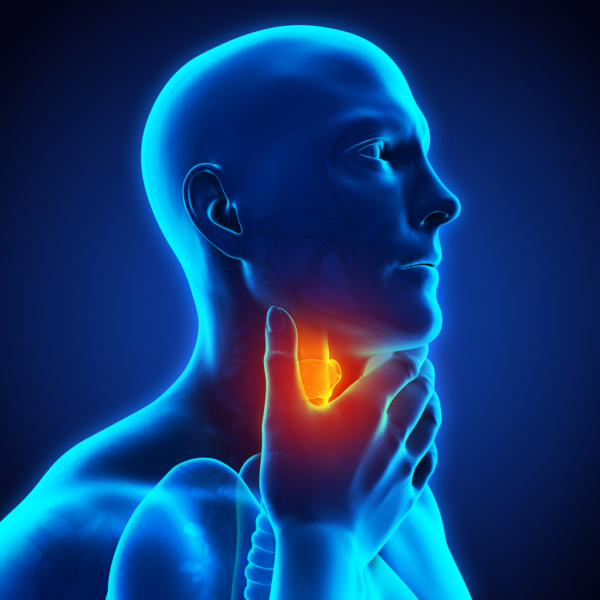Understanding Adam’s Apple Pain: Causes, Symptoms and Treatments
Have you ever experienced that uncomfortable sensation in your throat, right where your Adam’s apple is located?
It’s a pain that can be quite bothersome and may leave you wondering what’s causing it.
In this SANE MD blog post in throat health, Dr. Matthew Olesiak – who trained in surgical residency his first year, will delve into the common causes, symptoms, and treatments of Adam’s apple and throat pain below.
By the end of this informative journey, you will have a better understanding of this condition and how to address it effectively.
From throat infections to thyroid issues and even acid reflux, there are various factors that can contribute to Adam’s pain. Knowledge is power, and understanding the source of your discomfort is the first step toward finding relief.
So, let’s begin unraveling the mystery behind that pesky lump pain.

- New Report Says Your Brain Could Be the Key to Reducing Phlegm Over 50
- Doctor's "Leave The Throat Phlegm Behind" Tutorial Goes Viral With People Over 50
- Can You Relieve Throat Phlegm and Coughing In 60 Seconds A Day? This Doctor Says Yes
- How To Banish Phlegm When 50+ (Do This Every Day)
Throat Pain Key Takeaways
- Adam’s pain can be caused by throat infections, thyroid issues and acid reflux (GERD). Is there a concern for throat cancer?
- Symptoms include hoarseness of voice, difficulty in swallowing and swollen lymph nodes.
- Treatment options vary depending on the cause and may include medications, lifestyle modifications or surgical interventions. Preventive measures such as rest are recommended for optimal vocal health.
Common Causes of Apple Pain – sore throat?
The Adam’s apple, or laryngeal prominence, is a cartilaginous protrusion stemming from the larynx or voice box. Engulfing the thyroid and throat, it enables us to speak and swallow.
However, problems with the Adam’s apple could lead to discomfort and neck pain. The size of an individual’s Adam’s apple or laryngeal prominence can vary, with some having a large adam’s apple or laryngeal prominence more than others.
But what causes Adams apple pain? What came first – sore throat or a larger adam’s apple?
There are several medical conditions that can lead to discomfort in the Adam’s apple region.
Throat infections, thyroid issues, and acid reflux (GERD) are some of the most common causes.
We will delve into each of these factors to understand their role in causing Adam’s apple pain and their impact on a person’s overall health.
Throat Infections & Throat pain
A myriad of factors can lead to throat infections, such as influenza-causing viruses, the common cold, or yeast infections spreading from the mucus membrane lining the mouth and tongue to the esophagus.
These infections can sometimes lead to enlarged lymph nodes, which can further contribute to throat pain.
Diagnosing throat infections typically involves a physical examination and a throat swab. In some cases, if the throat pain is related to the size of the larger Adam’s apple, surgery might be recommended.
Treatment for throat infections generally involves rest, fluids, and over-the-counter pain relievers, while anti-fungal therapy may be prescribed for candida esophagitis.
Prevention of infection is key; frequent and thorough handwashing can help reduce the risk of throat infections and associated Adams apple pain.
Thyroid Issues
Situated just below the Adam’s apple in the neck, the thyroid gland significantly contributes to the regulation of the body’s metabolism.
Thyroid and thyroid-related issues, such as thyroid nodules, thyroid cancer, and acute thyroiditis, can all potentially cause Adams apple pain.
Symptoms of thyroid cancer, for example, can include:
- Swollen and inflamed lymph nodes closest to the thyroid
- Difficulty swallowing
- Presence of a lump or nodule at the front of the neck beneath the Adams apple region
When it comes to thyroid nodules, a prolonged cough may be a typical sign.
In some cases, a nodule compressing a nerve in the larynx can result other changes in voice and hoarseness.
Acute thyroiditis is a rare condition in which the thyroid gland becomes inflamed. It can be caused by:
- Infections
- Radiation
- Certain medications
- Trauma
If you suspect you have acute thyroiditis, immediate medical care at an emergency room is advised.
Acid Reflux (GERD)

Sore Throat Illustration. 3D render
Gastroesophageal reflux disease (GERD) is a condition in which stomach acid flows back into the esophagus, causing irritation and discomfort.
Symptoms of GERD can be painful. Burning sensation in both chest and throat are commonly experienced.
In some cases, it can also make swallowing difficult. Obesity, smoking, diabetes, hiatal hernia and pregnancy are known risk factors for GERD. These can increase the possibility of developing the condition..
Treatment for GERD typically includes:
- Over-the-counter antacids
- Lifestyle modifications, such as avoiding certain foods and losing weight
- Medication to reduce stomach acidity
- Surgery to reinforce the sphincter muscle at the lower end of the esophagus
Alleviating Adams apple pain can be achieved by addressing the underlying cause of acid reflux.
Symptoms Associated with Apple Pain
Having explored the common causes of Adams apple pain, it’s now crucial to identify the symptoms that could accompany this discomfort.
Some of the most common indicators of Adams apple pain include hoarseness of voice sore throat, difficulty in swallowing, and swelling of lymph nodes sore throat.
These symptoms can be linked to various conditions affecting the throat, thyroid gland, or esophagus.
Being aware of these symptoms is crucial in identifying the underlying cause of Adams apple pain.
By understanding the connection between these symptoms and their respective causes, it becomes easier to seek appropriate medical advice and treatment.
We will examine each symptom closely to understand their relation to other changes in the conditions triggering Adams apple pain.
Hoarse Voice
A hoarse voice is characterized by a raspy or breathy quality, which is caused by inflammation or irritation of the vocal cords. This symptom can be potentially caused by:
- Throat infections
- Thyroid issues
- Acid reflux (GERD)
- Vocal strain
- A nodule compressing a nerve in the larynx
Other symptoms associated with hoarseness include difficulty swallowing, a sore throat, and a dry cough.
Treatment options for hoarseness may include medications, lifestyle modifications, and surgical interventions.
Addressing the underlying cause of the hoarseness can help mitigate the associated Adam’s apple and jaw pain.
Difficulty Swallowing
Difficulty swallowing, also known as dysphagia, is a condition in which the act of swallowing food or liquids is difficult. Possible causes may include:
- Neurological and brain disorders
- Muscle disorders
- Narrowing or blockages in the throat or esophagus
- Certain medications
Symptoms associated with difficulty swallowing may include:
- Pain or discomfort when swallowing
- A sensation of food becoming lodged in the throat or chest
- Coughing or choking when ingesting or imbibing
- Regurgitating food or liquids
Treatment options for difficulty swallowing may include medications, lifestyle modifications, and surgical interventions.
Alleviating the associated Adam’s apple discomfort can be achieved by addressing the root cause of swallowing difficulty.
Swollen Lymph Nodes
Swollen lymph nodes are small, bean-shaped glands located throughout the body that assist in combating infection. They can become swollen due to a range of conditions, such as cancer such as: cancer
- Infections
- Allergies
- Autoimmune disorders
- Cancer
Swollen lymph nodes may be attributed to throat infections, thyroid issues, and acid reflux (GERD), which can all contribute to Adam’s apple pangs.
The most prevalent indication of swollen lymph nodes is a lump or enlargement in the neck, armpit, or groin. Other indications may include fever, chills, exhaustion, and body aches. Diagnosis of swollen lymph nodes typically involves a physical examination and imaging tests such as an ultrasound or CT scan, as well as blood tests to identify the underlying cause.
Treatment for swollen lymph nodes depends on the underlying cause and may include antibiotics, anti-inflammatory medications, or surgery.
Diagnosing the Cause
Proper diagnosis is key to finding the most effective treatment for Adams apple pain. Healthcare providers may utilize a combination of diagnostic methods to determine the underlying cause, including a physical examination, imaging tests, and blood tests. Each of these methods provides valuable information to help pinpoint the cause of discomfort and guide the appropriate treatment plan.
We will closely examine each diagnostic method and their contribution to identifying the cause of Adams apple pain. Once you understand the array of diagnostic tools available, you’ll be in a better position to discuss your symptoms and concerns with your healthcare provider.
Physical Examination
A physical examination is a medical procedure in which a doctor examines the patient’s body to detect any signs of disease or injury. In the case of Adams apple pain, the doctor will assess the patient’s throat and neck area for indications of swelling, tenderness, or other irregularities. A stethoscope may also be employed in order to listen to the patient’s breathing and heart rate.
Imaging tests and blood tests may be employed in conjunction with the physical examination to ascertain the cause of Adams apple pain. These diagnostic tools provide a more comprehensive view of the patient’s condition, helping to identify any underlying medical issues that may be causing the discomfort.
Imaging Tests
Imaging tests are medical procedures that enable physicians to gain visual access to the interior of the body and acquire images of the internal structures. Common imaging tests used to diagnose the cause of Adams apple pain include X-rays, CT scans, and MRI scans. These and other tests enable physicians to diagnose disorders and ascertain their severity.
These diagnostic tools can provide valuable information about the patient’s condition, helping to identify any abnormalities or issues that may be causing Adams apple pain. Healthcare providers can gain a comprehensive understanding of the patient’s condition and recommend an effective treatment plan by integrating imaging tests with a physical examination and blood tests.
Blood Tests
Blood tests are examinations that ascertain the concentrations of specific substances in the blood, including hormones, proteins, and other compounds. These tests can be utilized to diagnose a variety of ailments, including Adams apple pain.
A complete blood count (CBC) and thyroid function tests can be utilized to diagnose Adams apple pain. The potential outcomes of blood tests can assist in determining the origin of Adam’s apple pain, such as thyroid issues, throat infections, or acid reflux (GERD).
By combining blood tests with imaging tests and a physical examination, healthcare providers can develop a comprehensive understanding of the patient’s medical condition, and recommend the most appropriate treatment plan.
Treatment Options
Once the cause of Adams apple pain has been identified, a suitable treatment plan can be developed. Treatment options may include medications, lifestyle changes, and surgical interventions. The specific treatment plan will depend on the underlying cause of the pain, as well as the patient’s overall health and preferences.
We will delve into the various treatment options for Adams apple pain and their role in relieving discomfort and enhancing overall health.
Medications
Medications can play a significant role in addressing Adams apple pain. Over-the-counter pain relievers such as aspirin or ibuprofen can help reduce discomfort and inflammation. It is important to note that aspirin should not be administered to children.
In certain cases, severe pain and inflammation may necessitate steroid therapy. Additionally, proton pump inhibitors like Omeprazole may be prescribed for reflux-related pain.
Before starting any medication, consulting a healthcare provider is crucial to ensure it fits your specific medical condition well. A professional medical advice can help determine the most effective treatment plan to alleviate Adams apple pain.
Lifestyle Changes
Making certain lifestyle changes can help alleviate or prevent Adams apple pain. These changes may include implementing dietary modifications, such as avoiding spicy and acidic foods, consuming smaller meals, and refraining from caffeine. Weight loss has also been known to reduce pressure on the throat and minimize the symptoms associated with Adams apple pain.
Incorporating relaxation exercises and meditation can assist in reducing stress and tension, which may help in relieving apple pain. Resting one’s voice and consuming warm water with honey may also prove beneficial in alleviating the symptoms associated with Adam’s apple pain.
A precise diagnosis and tailored treatment plan require a diagnosis and consultation with a physician or a healthcare professional.
Surgical Interventions
In certain instances, surgery may be necessary to treat Adams pple pain. Surgical interventions can include tracheal shave (chondrolaryngoplasty) and Adams apple reduction surgery (chondrolaryngoplasty or thyroid cartilage reduction surgery). These procedures involve removing a portion of the thyroid cartilage in order to diminish the size of the Adam apple.
Even though surgical interventions, such as adam’s apple surgery, can effectively address the root cause of Adams apple pain, discussing the risks and benefits of surgery with a doctor or a healthcare provider is crucial before deciding on a treatment direction. Surgery should be considered as a last resort when other treatment options have proven ineffective.
When to Seek Professional Medical Advice
It is imperative to seek professional medical advice if you experience persistent or severe Adams apple pain, as this may indicate an underlying medical condition requiring treatment. Symptoms that warrant medical consultation include:
- A sore throat and or swollen Adam’s apple
- Pain outside of the throat or while swallowing
- A mass on the side of the neck accompanied by hoarseness, cough, difficulty swallowing, or swollen lymph nodes. Possible vocal cords involved.
Seeking professional medical advice will ensure that the cause of your Adam’s apple pain is properly identified and addressed. Timely intervention can help alleviate pain, prevent complications, and improve overall health and well-being.
Preventive Measures
Being proactive about your health can help prevent Adam’s apple pain. Some preventive measures include:
- Resting the voice (leave your vocal cords alone!)
- Avoiding irritants such as smoking and environmental pollutants
- Staying hydrated by drinking plenty of water
- Utilizing a cool-mist humidifier to maintain air humidity and decrease inflammation in the throat
Incorporation of these preventive measures into your daily routine can mitigate the risk of developing Adam’s apple pain and help maintain your optimal vocal health. Remember, prevention is always better than cure.
Summary & Next Steps
Adam’s apple pain can be caused by various conditions such as throat infections, thyroid issues, and acid reflux. By understanding the common causes, symptoms, and treatments, you can take charge of your health and find the most appropriate solution for your discomfort. Remember to seek professional medical care and advice if you experience persistent or severe Adam’s apple pain, as timely intervention can help prevent complications and improve overall well-being.
Keep in mind that prevention is key. By adopting healthy habits and making necessary lifestyle changes, you can reduce the risk of developing Adam’s apple pain and ensure optimal vocal health. Take care of your voice, and it will take care of you and as per usual – rest your vocal cords!

- New Report Says Your Brain Could Be the Key to Reducing Phlegm Over 50
- Doctor's "Leave The Throat Phlegm Behind" Tutorial Goes Viral With People Over 50
- Can You Relieve Throat Phlegm and Coughing In 60 Seconds A Day? This Doctor Says Yes
- How To Banish Phlegm When 50+ (Do This Every Day)
Frequently Asked Questions
1. What does it mean when your Adam’s apple hurts?
Pain in your Adam’s apple could indicate a throat infection or inflammation. Consulting a doctor is advised to rule out more serious conditions. Also, consider speaking to the physician about any cough or conditions affecting the laryngeal prominence in your anatomy. Large adam’s apple person does exist so you should not feel like you’re the only one suffering here!
2.Why does my throat hurt when I touch it from the outside?
Touching your throat may cause pain due to acute thyroiditis or inflammation of the epiglottis, which is located near the Adam’s apple.
SANE MD TRENDING ARTICLES:
Dr. Matthew Olesiak, MD, is the Chief Medical Director at SANESolution, a renowned wellness technology company dedicated to providing evidence-based solutions for optimal living. Dr. Olesiak earned his medical degree from the prestigious Jagiellonian University Medical College in Kraków, Poland, where he developed a strong foundation in medicine.






